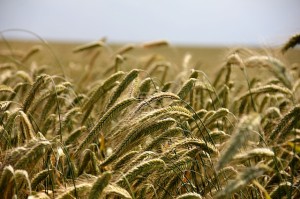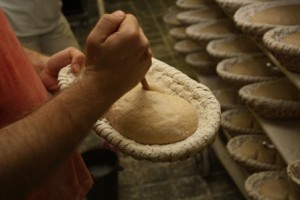
Traditional Czech Bread
If you ask the Czech expats, students or simply people who spend a lot of time outside the Czech Republic, what they miss the most, many of them will tell that it is the traditional Czech bread. It really is the cornerstone of Czech culinary tradition and cannot be found anywhere else. What makes the Czech bread so special? Is it the shape, colour of the crust or its typical sourness? Or is it the caraway which is traditionally used in Czech bread? It is all of the above and something more.
Rye flour makes the difference
The basic ingredients used for the Czech bread are rye and  wheat flours. Depending on the proportion of the two we then call the bread either rye-wheat bread (more ryeflour than wheatflour) or wheat-rye bread. The proportion of these two flours in the typical Czech bread varies and depends to a large extent on local customs. The most balanced option is a 1:1 ratio with slight predominance of wheat flour. The difference, when compared to standard white, purely wheat bread is really obvious.
wheat flours. Depending on the proportion of the two we then call the bread either rye-wheat bread (more ryeflour than wheatflour) or wheat-rye bread. The proportion of these two flours in the typical Czech bread varies and depends to a large extent on local customs. The most balanced option is a 1:1 ratio with slight predominance of wheat flour. The difference, when compared to standard white, purely wheat bread is really obvious.
Rye has a long tradition as crop in Central Europe – it dates back to the Middle Ages. Rye has quite different characteristics than wheat. It contains much less gluten which affects the stickiness, firmness and taste. In order to achieve the desired results we need to help the dough a bit and add leaven – preferably homemade. The leaven consists of pre-yeastedflour and water.
Leaven is the secret
The need to prepare bread this way due to the addition of rye flour gave birth to a new tradition. The leaven is in fact a living organism producing CO2 and making the dough all fluffy which is the reason for its bubbled structure. The original Czech leaven which has been a part of the Czech culinary tradition for generations is considered a little miracle. It has all you need to make good bread. This, water and more flour depending on the amount of bread you wish to bake. It has the yeast necessary for the dough to rise nicely and lactic acid bacteria giving the classic sour taste. What is more, it is completely natural which contributes to its wonderful typical smell and long lasting freshness.
 The credit for this process goes to enzymes, bacteria spores and yeast cells which are naturally contained in flour. The enzymes then simply begin degrading the flour starch into lower sugars. This provides a perfect culture medium for bacteria and yeast cells which start to reproduce themselves uncontrolledly.
The credit for this process goes to enzymes, bacteria spores and yeast cells which are naturally contained in flour. The enzymes then simply begin degrading the flour starch into lower sugars. This provides a perfect culture medium for bacteria and yeast cells which start to reproduce themselves uncontrolledly.
The last thing necessary when preparing this type of bread is to carefully balance the ingredients. Although too much yeast can help the rising, the bread may not be so tasty. The ratio of rye flour and wheat flour has also influence on the whole process.
Various ways of preparing the leaven have been developed,because each baker tended to accommodate his own needs and tastes. But proper preparation of good leaven takes some time and since time is money, many baking companies developed quicker but more artificial ways of making the dough rise. This, of course, affects the quality of bread in supermarkets and it is getting still more difficult to find proper bread made in the traditional way. Luckily enough, the number of people baking their own bread is still on the increase, so let’s hope that the tradition never dies.







Leave a Reply: